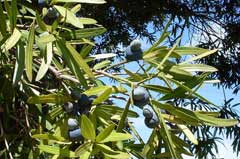 |
|
http://commons.wikimedia.org/wiki/File:Podocarpus_elatus00.jpg |
 |
|
Translate this page:
Summary
Physical Characteristics

 Podocarpus elatus is an evergreen Tree growing to 30 m (98ft 5in).
Podocarpus elatus is an evergreen Tree growing to 30 m (98ft 5in).
See above for USDA hardiness. It is hardy to UK zone 10. It is in leaf all year, and the seeds ripen in October. The species is dioecious (individual flowers are either male or female, but only one sex is to be found on any one plant so both male and female plants must be grown if seed is required). and is pollinated by Wind. The plant is not self-fertile.
Suitable for: light (sandy), medium (loamy) and heavy (clay) soils and prefers well-drained soil. Suitable pH: mildly acid and neutral soils. It can grow in semi-shade (light woodland) or no shade. It prefers moist soil. The plant can tolerate maritime exposure.
UK Hardiness Map
US Hardiness Map
Synonyms
Plant Habitats
Woodland Garden Canopy;
Edible Uses
Edible Parts: Fruit
Edible Uses:
Fruit - raw or cooked[156, 157]. It makes a tasty jelly[167]. Rich and sweet[193]. Mucilaginous with a resinous flavour[183, 193]. A reasonable size, the fruit is about 25mm in diameter[167]. The seed is borne on the top of the fruit[193].
References More on Edible Uses
Medicinal Uses
Plants For A Future can not take any responsibility for any adverse effects from the use of plants. Always seek advice from a professional before using a plant medicinally.
None known
References More on Medicinal Uses
The Bookshop: Edible Plant Books
Our Latest books on Perennial Plants For Food Forests and Permaculture Gardens in paperback or digital formats.

Edible Tropical Plants
Food Forest Plants for Hotter Conditions: 250+ Plants For Tropical Food Forests & Permaculture Gardens.
More

Edible Temperate Plants
Plants for Your Food Forest: 500 Plants for Temperate Food Forests & Permaculture Gardens.
More

More Books
PFAF have eight books available in paperback and digital formats. Browse the shop for more information.
Shop Now
Other Uses
Wood
Wood - tough, durable, silky textured. Used for cabinet making, indoor use and boat building[156, 167].
Special Uses
References More on Other Uses
Cultivation details
Prefers a rich moist non-alkaline soil[167]. Resists salt spray[157]. Grows best in areas with a humid climate[200]. Plants tolerate temperatures down to at least -7°c in Australian gardens[157], but this cannot be translated directly to British gardens because of our cooler summers and longer colder and wetter winters. They can be grown outdoors in the milder areas of Britain, preferably in a woodland garden[166]. Plants in this genus are notably resistant to honey fungus[200]. Dioecious. Male and female plants must be grown if seed is required.
References Carbon Farming Information and Carbon Sequestration Information
Temperature Converter
Type a value in the Celsius field to convert the value to Fahrenheit:
Fahrenheit:
The PFAF Bookshop
Plants For A Future have a number of books available in paperback and digital form. Book titles include Edible Plants, Edible Perennials, Edible Trees,Edible Shrubs, Woodland Gardening, and Temperate Food Forest Plants. Our new book is Food Forest Plants For Hotter Conditions (Tropical and Sub-Tropical).
Shop Now
Plant Propagation
The seed can be sown at any time of the year in a sandy soil in a warm greenhouse, though it is probably best sown as soon as it is ripe[1]. When they are large enough to handle, prick the seedlings out into individual pots and grow them on in the greenhouse for at least their first winter. Plant them out into their permanent positions in late spring or early summer, after the last expected frosts. Cuttings of half-ripe terminal shoots, 5 - 10cm long, July/August in a frame[78].
Other Names
If available other names are mentioned here
Native Range
AUSTRALASIA: Australia (New South Wales (east), Queensland (east))
Weed Potential
Right plant wrong place. We are currently updating this section.
Please note that a plant may be invasive in one area but may not in your area so it's worth checking.
Conservation Status
IUCN Red List of Threatened Plants Status :

Growth: S = slow M = medium F = fast. Soil: L = light (sandy) M = medium H = heavy (clay). pH: A = acid N = neutral B = basic (alkaline). Shade: F = full shade S = semi-shade N = no shade. Moisture: D = dry M = Moist We = wet Wa = water.
Now available:
Food Forest Plants for Mediterranean Conditions
350+ Perennial Plants For Mediterranean and Drier Food Forests and Permaculture Gardens.
[Paperback and eBook]
This is the third in Plants For A Future's series of plant guides for food forests tailored to
specific climate zones. Following volumes on temperate and tropical ecosystems, this book focuses
on species suited to Mediterranean conditions—regions with hot, dry summers and cool, wet winters,
often facing the added challenge of climate change.
Read More
Expert comment
Author
R.Br. ex Mirb.
Botanical References
200265
Links / References
For a list of references used on this page please go here
Readers comment